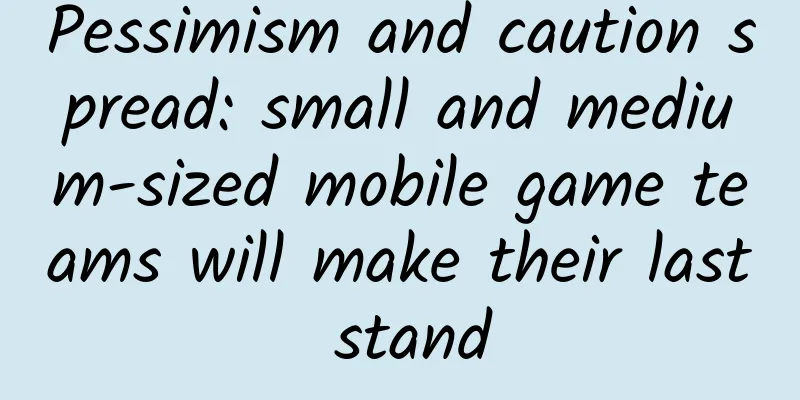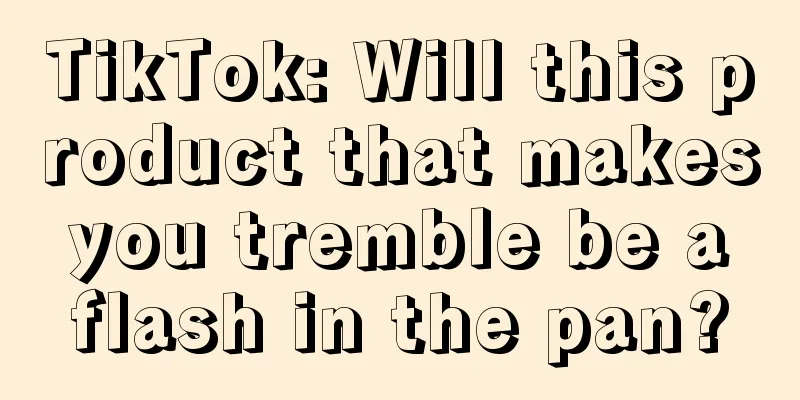Pessimism and caution spread: small and medium-sized mobile game teams will make their last stand

|
Nowadays, "recruitment is much better than before," an executive of a listed company commented on the labor market disrupted by the entrepreneurial boom. The reason why recruitment has become easier is obvious: a large number of mobile game entrepreneurs are experiencing a brutal wave of failure, and they are returning to the large company system with various new identities.
Entrepreneurship The changes in the domestic mobile game market are just like the recent trend of the domestic A-shares. After a round of sharp rise, there will inevitably be a round of sharp fall. What will be eliminated is the bubble created by venture capital leverage. Unfortunately, a large number of small and medium-sized entrepreneurial teams have become the bubble of this round of mobile game entrepreneurship boom. In terms of product supply, at least for now, the number of products is still growing in the first half of this year. For example, according to the Q2 2015 data recently released by UC Jiuyou, the number of new mobile games added to the channel in the second quarter was 734, with an average of 240 per month. In comparison, there were only 120 new products in October 2014. However, the growth in absolute numbers cannot conceal the bloat on the mobile game R&D side. "In the first half of this year, we actually reviewed 1,000 products, excluding those that were not worth reviewing. However, in the second half of last year, we tested more than 2,000 products, a significant decrease in number." A big boss of a publisher told gamelook that the number of products that can catch the publisher's eye is decreasing, mainly because the quality of industry products has improved since this year. "We looked at 1,000 titles, but we only signed one." Gamelook was very surprised that this listed company with abundant funds only signed one title. The reason given by the publisher was still the product quality and the reliability of the team. In addition, the company's publishing business no longer uses the method of taking a batch, testing a batch, and then showing the products last year. The main way out for products from small and medium-sized teams is to be represented by large publishers. It would be fine if only one company did this, but in fact, major first-line publishers are becoming increasingly cautious in signing products. The reason is the increase in the threshold for product distribution and the improvement in product quality. "Nowadays, if the R&D cost of a mobile game is less than 5 million, it is basically impossible." Another reason why the publisher is gradually giving up on the products of small and medium-sized companies is that IP products are dominating the mobile game market and small companies do not have the money to sign IP. If no one wants the products of small companies, does that mean that the number of new products from publishers will decrease? No, publishers have gone to the other extreme: IP customized products, self-development, and even acquisition and holding of small and medium-sized teams. Now, a large number of small and medium-sized teams are seeking help from publishers with IP reserves, hoping to use the publisher's IP advantages to increase the success rate of their products. However, since everyone is doing this, there is bound to be an imbalance between supply and demand of publishers' IPs. At the same time, IPs can be divided into good IPs and bad IPs, so small and medium-sized teams may not be able to be assigned a reliable IP. "Nowadays, many small and medium-sized companies are trying to make products such as MMO, but such products are very difficult and many are unreliable." The advantage of small and medium-sized teams is that they are easy to turn around, but the sad thing is that a large number of entrepreneurial teams have chosen the direction of heavy mobile games that are difficult and require large investments. It is difficult to truly digest a large amount of development work with enthusiasm alone, not to mention that small and medium-sized companies face the dilemma of difficulty in recruiting. In gamelook's opinion, many start-up teams face problems at the project establishment stage. The project directions are often too mainstream and the types are too single. At the same time, many new products released this year have mostly failed in product quality. Research and development based on last year's industry art and technical standards are no longer able to cope with the fierce market competition in 2015. Why would a large game company with financial strength, IP advantages, and team advantages sign a contract with a small or medium-sized team for a heavy product? In the view of GameLook, the main reason why large companies continue to act as agents for small or medium-sized team products to a certain extent at this stage is to supplement their self-developed product lines. The purpose of the supplement is to supplement the sub-types that large companies do not have the energy to develop or do not have a suitable internal team to develop, and at the same time, they hope to borrow the innovative ability of small and medium-sized teams to try and error in the sub-market. "We have been looking for a reliable turn-based development team for a year, but we still haven't found one." The statement of the publisher's executives somewhat illustrates the misalignment between market supply and the actual needs of publishers. However, the current situation is that a large number of small and medium-sized teams are still continuing the model of doing what big companies do and copying whatever products are successful. "It is basically difficult to succeed at this stage to use a copycat product to compete with the leading product. At present, a product with a copycat gameplay can only achieve a certain degree of success by converting fans into game users through IP." This also explains why, among the large number of products that copied "Dota Legend", no Dota-themed counterfeit product has ever been successful in China. With the pressure of capital and product launch time, small and medium-sized teams are facing a life-or-death moment. Independent development, independent thinking and pursuit of innovation are the reasons for the existence of small and medium-sized teams. However, the domestic mobile game market in 2015 is telling entrepreneurs the answer with a cruel wave of failures. |
<<: Weird ways to "die" in games
>>: Windows 10 collects a lot of privacy? Teach you how to protect your information
Recommend
Whether it is bidding or information flow, you can spend more money, but it must not be ineffective
If we talk about the two most popular traffic cha...
Data operation: How does big data make users more willing to pay?
When a product reaches a certain stage of develop...
The eighth course of the Xiaomao Qianqian Writing Training Camp
The course comes from the eighth session of Xiaom...
Weibo, WeChat and Douyin: New rules for brands
Li Jiaoshou once said in the 2020 New Marketing N...
Orange cat super short combat crash course (first period)
Resource introduction of Orange Cat Super Short P...
Zhihu's "Seven-Day Unconditional Refund" disrupts knowledge payment: Come on, let's hurt each other
On that special train to April, to the springtime...
Key points and analysis of public relations and marketing plan!
"Marketing planning" is a relatively va...
Internet enterprise operation and promotion plan (mind map)
We should all know that there are several work sc...
Is it difficult to make a small program yourself? Is it difficult to make your own mini-program?
Is it difficult to make a small program yourself?...
2019 Fliggy 3rd Anniversary Event Planning and Promotion Plan!
This article mainly wants to share with you my pe...
6 major information flow advertising platforms, which channel is the most powerful
iResearch predicts that in the next two years, in...
Analysis of the principle of Choreographer screen refresh mechanism
[[439195]] This article is reprinted from the WeC...
When the whole world is talking about Swift open source - 2015 Objective-C new features
Overview Since the launch and open source of Swif...
China Mobile Internet Development Report, Q3 2016
Report highlights • As of Q3 2016, the total numb...
Methodology for creating hot-selling traffic products!
Recently, I managed a growth plan for a star comp...









